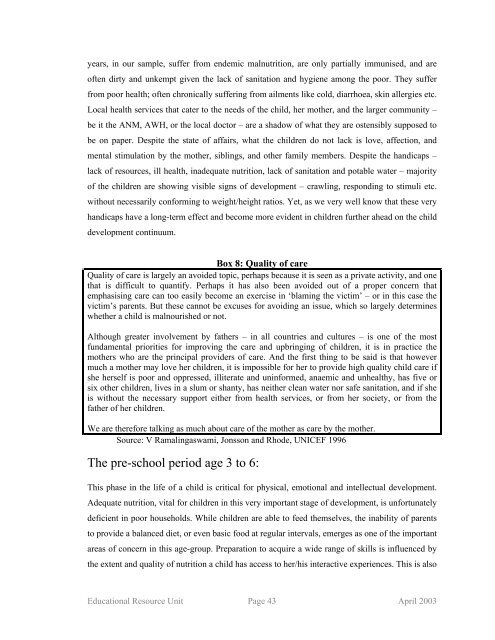Snakes and Ladders - ERU Consultants Pvt. Ltd.
Snakes and Ladders - ERU Consultants Pvt. Ltd.
Snakes and Ladders - ERU Consultants Pvt. Ltd.
You also want an ePaper? Increase the reach of your titles
YUMPU automatically turns print PDFs into web optimized ePapers that Google loves.
years, in our sample, suffer from endemic malnutrition, are only partially immunised, <strong>and</strong> are<br />
often dirty <strong>and</strong> unkempt given the lack of sanitation <strong>and</strong> hygiene among the poor. They suffer<br />
from poor health; often chronically suffering from ailments like cold, diarrhoea, skin allergies etc.<br />
Local health services that cater to the needs of the child, her mother, <strong>and</strong> the larger community –<br />
be it the ANM, AWH, or the local doctor – are a shadow of what they are ostensibly supposed to<br />
be on paper. Despite the state of affairs, what the children do not lack is love, affection, <strong>and</strong><br />
mental stimulation by the mother, siblings, <strong>and</strong> other family members. Despite the h<strong>and</strong>icaps –<br />
lack of resources, ill health, inadequate nutrition, lack of sanitation <strong>and</strong> potable water – majority<br />
of the children are showing visible signs of development – crawling, responding to stimuli etc.<br />
without necessarily conforming to weight/height ratios. Yet, as we very well know that these very<br />
h<strong>and</strong>icaps have a long-term effect <strong>and</strong> become more evident in children further ahead on the child<br />
development continuum.<br />
Box 8: Quality of care<br />
Quality of care is largely an avoided topic, perhaps because it is seen as a private activity, <strong>and</strong> one<br />
that is difficult to quantify. Perhaps it has also been avoided out of a proper concern that<br />
emphasising care can too easily become an exercise in ‘blaming the victim’ – or in this case the<br />
victim’s parents. But these cannot be excuses for avoiding an issue, which so largely determines<br />
whether a child is malnourished or not.<br />
Although greater involvement by fathers – in all countries <strong>and</strong> cultures – is one of the most<br />
fundamental priorities for improving the care <strong>and</strong> upbringing of children, it is in practice the<br />
mothers who are the principal providers of care. And the first thing to be said is that however<br />
much a mother may love her children, it is impossible for her to provide high quality child care if<br />
she herself is poor <strong>and</strong> oppressed, illiterate <strong>and</strong> uninformed, anaemic <strong>and</strong> unhealthy, has five or<br />
six other children, lives in a slum or shanty, has neither clean water nor safe sanitation, <strong>and</strong> if she<br />
is without the necessary support either from health services, or from her society, or from the<br />
father of her children.<br />
We are therefore talking as much about care of the mother as care by the mother.<br />
Source: V Ramalingaswami, Jonsson <strong>and</strong> Rhode, UNICEF 1996<br />
The pre-school period age 3 to 6:<br />
This phase in the life of a child is critical for physical, emotional <strong>and</strong> intellectual development.<br />
Adequate nutrition, vital for children in this very important stage of development, is unfortunately<br />
deficient in poor households. While children are able to feed themselves, the inability of parents<br />
to provide a balanced diet, or even basic food at regular intervals, emerges as one of the important<br />
areas of concern in this age-group. Preparation to acquire a wide range of skills is influenced by<br />
the extent <strong>and</strong> quality of nutrition a child has access to her/his interactive experiences. This is also<br />
Educational Resource Unit Page 43 April 2003












